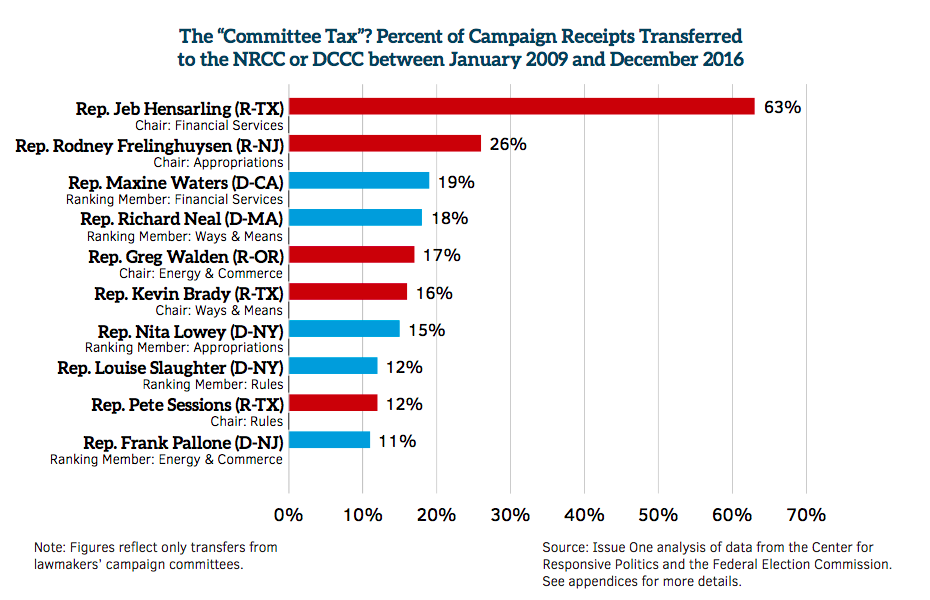Press releases
New Report: The Price of Power
How Political Parties Squeeze Influential Lawmakers to Boost their Campaign Coffers
Media Contact
Cory Combs
Director of Media Relations
A new report from Issue One called “The Price of Power” details how the chairs and ranking members of the most influential committees in the U.S. House of Representatives are increasingly being pressured by party leadership to funnel significant portions of the funds they raise back to the National Republican Congressional Committee (NRCC) and Democratic Congressional Campaign Committee (DCCC) under the current “party dues” system.
At the extreme, House Financial Services Committee Chair Rep. Jeb Hensarling (R-TX) transferred more than $3 of every $5 he raised for his campaign committee during the past eight years back to the NRCC, according to this first-of-its-kind analysis of campaign finance data by Issue One — a total of $6.3 million.
Other powerful lawmakers typically transferred between 10 percent and 20 percent of the money they raised for their campaign coffers over the past eight years to the NRCC or DCCC, according to Issue One’s analysis of data from the Center for Responsive Politics and the Federal Election Commission.
“At its core, the ‘party dues’ system reeks of extortion,” said Issue One Executive Director Nick Penniman. “It’s perverse that political parties — which are not an official part of our government — are allowed to distort the process and place congressional committee assignments on their own auction blocks and dictate astronomical fundraising quotas to lawmakers.”
Because lawmakers’ fundraising quotas for the DCCC and NRCC are kept hidden from public view, Issue One calls on House leaders of both parties to immediately make transparent how much elected lawmakers are expected to raise on the parties’ behalf by “dialing for dollars.”
Issue One’s research found that GOP leaders currently expect each chair of an “A” committee — such as Appropriations — to raise $1.2 million for the NRCC and each chair of a “B” committee — such as Education and the Workforce — to raise $875,000 for the NRCC. Rank-and-file members of these committees are expected to raise $450,000 and $325,000, respectively, for the NRCC. House Democrats are likewise generally expected to raise six- or seven-figure sums for the DCCC.
“The ‘price of power’ in Congress is essentially a heavy-handed ‘tax’ on top legislative leaders,” said Issue One Chief of Policy, Programs and Strategy Meredith McGehee. “The House has the power and the responsibility to take action. The factors that determine who serves as a committee chair should be based more on expertise and years of public service, and not just how successful — or dedicated — they are at raising money.”
The American public is likely to be surprised to learn that channeling money to the parties has become standard operating procedure for legislative leaders. Issue One specifically found that over the past eight years:

Moreover, Issue One’s analysis shows how top Republican and Democratic lawmakers use both their campaign committees and leadership PACs to boost the coffers of the NRCC, DCCC and other members of Congress. These vehicles are typically used to curry favor with other lawmakers.
Not only does the new “The Price of Power” report detail the extent to which high-ranking lawmakers delivered millions of dollars back to their parties, it further reveals how the top Republican and Democratic lawmakers on these select congressional committees likewise collected sizable sums of money from the special interests they regulate as they rose to prominence or fought to maintain their prominent positions.
These trends over the past eight years — observable because of industry coding by the Center for Responsive Politics — were also striking. A few highlights:
- 50 percent of the money Financial Services Committee Chair Jeb Hensarling (R-TX) raised for his campaigns came from the finance, insurance and real estate sector.
- 36 percent of the money Rep. Richard Neal (D-MA), the top Democrat on the Ways and Means Committee, raised for his campaigns came from the finance, insurance and real estate sector.
- 26 percent of the money Rep. Maxine Waters (D-CA), the top Democrat on the Financial Services Committee, raised for her campaigns came from the finance, insurance and real estate sector.
- 21 percent of the money Ways and Means Committee Chair Kevin Brady (R-TX) raised for his campaigns came from the finance, insurance and real estate sector.
Read the full report, which was informed by interviews with more than a dozen members of Issue One’s ReFormers Caucus, and explore the accompanying data, infographics and policy solutions: “The Price of Power: A deep-dive analysis into how political parties squeeze influential lawmakers to boost campaign coffers.”
Issue: Party Dues
